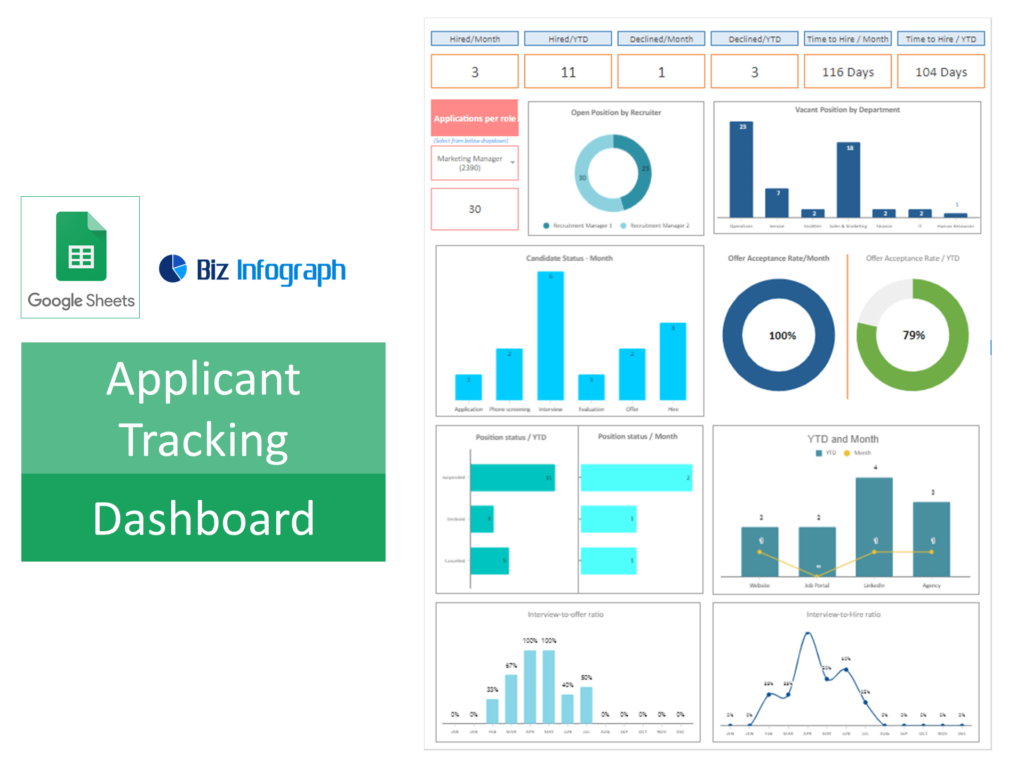
Introduction to Applicant Tracking System Dashboards
Understanding the Role of ATS in Modern Recruitment
Applicant Tracking Systems (ATS) revolutionize the recruitment landscape by streamlining hiring workflows and providing detailed analytics. These systems facilitate efficient candidate tracking and management, significantly reducing administrative burdens. Integrating an ATS dashboard within Google Sheets or Excel allows HR teams to visualize complex data, making strategic recruitment decisions based on real-time insights and improving overall hiring success rates.
Benefits of Integrating an ATS Dashboard
An ATS dashboard offers a consolidated view of recruitment solution metrics, enhancing the ability to track the efficiency of hiring processes. By implementing a dashboard, recruiters can quickly identify areas of improvement, monitor candidate progress, and optimize recruitment strategies. This centralized approach saves time and significantly improves the quality of hiring decisions, contributing to a stronger employer brand and a more engaged candidate pool. This dashboard helps to attract the best talent and eventually recruit qualified candidates.
Building Your ATS Dashboard
Key KPI to Include in Your Recruitment Dashboard
Effective ATS dashboards should track essential recruitment KPIs such as time-to-hire, cost-per-hire, application sources, resume sources, pipeline candidate, and candidate engagement levels. Including these metrics provides a holistic view of the recruitment process, enabling HR teams to identify bottlenecks and optimize strategies. Tailoring these KPIs to align with organizational goals ensures that the dashboard remains a relevant and powerful tool for recruitment analysis.
Customizing Your ATS Dashboard KPIs for Optimal Use
To maximize the utility of your ATS dashboard, customize key metrics to reflect specific recruitment objectives and company culture. This involves personalizing layouts, color schemes, and data points within Google Sheets or Excel to align with your recruitment metrics. Effective customization aids in better data interpretation and enhances user engagement with the dashboard.
Advanced Features and Analytics
Leveraging Recruitment Data for Strategic Insights
Utilizing advanced analytics within your ATS dashboard allows for deeper insights into recruitment patterns and candidates’ behavior. Analyze data trends to refine sourcing methods, enhance candidate experiences, and improve overall recruitment and onboarding outcomes. Strategic use of analytics helps identify the most effective recruitment channels and informs future hiring practices.
Utilizing Filters and Widgets to Enhance Dashboard Functionality
Incorporate filters and widgets into your ATS dashboard to streamline data analysis and enhance user experience. These features enable recruitment teams to sort and visualize data more efficiently, focusing on specific areas or metrics as needed. Customizing these elements within Google Sheets or Microsoft Excel enhances the dashboard’s functionality, making it a more effective tool for daily recruitment activities for the entire organization.
Dashboard Maintenance and Optimization
Updating and Maintaining Your Recruitment Dashboard
Ensure your ATS dashboard remains effective by conducting regular automation updates and maintenance. This includes refreshing recruiting software, data sources and format, verifying metric accuracy, and revising visual elements to reflect current recruitment trends. Keeping your dashboard up-to-date ensures that it continues to provide valuable insights and supports informed decision-making.
Best Practices for Recruitment Dashboard Management
Adhere to best practices such as setting clear data standards, performing routine checks, and managing user permissions to maintain dashboard integrity. Organized and well-managed dashboards lead to more accurate data analysis, better recruitment outcomes, and increased efficiency within HR teams.
Recruitment Analytics and Decision Making
Analyzing Recruitment Trends and Patterns
Systematically review your ATS dashboard to uncover recruitment trends and patterns. This analysis helps HR teams understand the effectiveness of their hiring strategies and identify opportunities for improvement. By tracking trends over time, recruiters can make data-driven decisions that enhance the recruitment process and candidate quality.
Driving Recruitment Strategies Based on Dashboard Analytics
Transform analytics into actionable recruitment strategies by leveraging insights gained from your ATS dashboard. Use data to refine hiring practices, improve candidate sourcing, and enhance interview processes. Implementing changes based on dashboard analytics leads to more efficient recruitment workflows and higher-quality hires.
Collaboration and Sharing Insights
Collaborative Features of ATS Dashboards
Maximize the collaborative potential of your ATS dashboard by sharing insights with HR colleagues and department managers. Google Sheets and Excel offer features that facilitate teamwork, allowing multiple users to contribute to and analyze recruitment data. This shared approach fosters transparency and collective problem-solving within the recruitment process.
Presenting Recruit Insights to Stakeholders
Prepare and deliver impactful presentations to stakeholders using data from your ATS dashboard. Highlight key findings, trends, and actionable insights to inform and engage senior management. Effective presentations demonstrate the value of data-driven recruitment strategies and support continued investment in HR technologies and resources.
Utilizing ATS Dashboards for Continuous Improvement
Leveraging Dashboard Insights for Recruitment Process Improvement
Utilize continuous feedback and data analysis to enhance and refine recruitment processes. Insights derived from the ATS dashboard should guide optimizations, from streamlining application stages to improving candidate communication. Regularly applying these insights leads to more effective and efficient recruitment practices.
Adapting Recruitment Strategies to Meet Evolving Needs
Stay adaptable and responsive to changing recruitment demands by regularly reviewing and updating your ATS dashboard. Use evolving market trends and organizational changes as opportunities to reassess and refine recruitment strategies. This agile approach ensures that your recruitment practices remain aligned with current objectives and market conditions.
FAQs and Troubleshooting
Common Questions About ATS Dashboards
Address frequent inquiries about setting up, customizing, and utilizing ATS dashboards within the recruitment process. Providing clear, concise answers helps demystify dashboard usage for HR teams and enhances the overall effectiveness of recruitment analytics.
Troubleshooting Typical ATS Dashboard Issues
Offer solutions for common challenges encountered when managing ATS dashboards, from data discrepancies to integration hurdles. Establishing a troubleshooting guide ensures that recruitment teams can resolve issues quickly and maintain the functionality of their dashboards.
For ready-to-use Dashboard Templates: